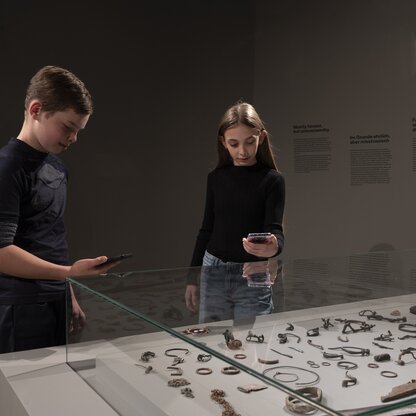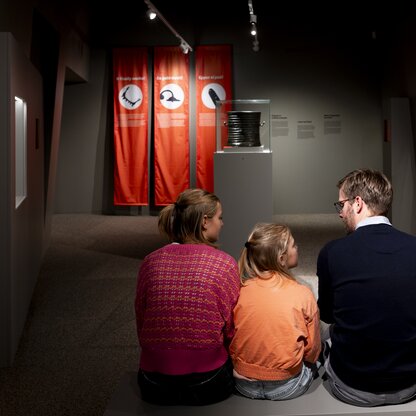UNDER PROPAGANDA - Archaeology between war and peace
Archaeology in the service of ideology:
the new special exhibition at the South Tyrol Museum of Archaeology in Bolzano, from November 25, 2025 to November 8, 2026.
Archaeology reveals history and in the 20th century, it became a part of political history. Between 1920 and 1972, archaeology in South Tyrol was caught in the maelstrom of authoritarian systems. Fascist Italian researchers sought evidence of South Tyrol’s “Roman past,” while Nazi scientists exploited prehistoric finds as “Germanic heritage.” The exhibition UNDER PROPAGANDA shows the extent to which archaeological artifacts and excavations have been overinterpreted according to ideologies and politically misused – and how long the tensions that resulted from this lingered. Many finds are being presented for the first time and have been scientifically reinterpreted based on current research. Interactive stations offer insights into historical excavation documents and illustrate the working practices of generations past. A diverse program of activities and events for both children and adults makes the exhibition appealing to a wide audience.
The exhibition is aimed both at specialists interested in these topics as well as the general public.
The Research Project
The exhibition is the result of a year-long research project. Archaeologists Andreas Putzer and Günther Kaufmann from the South Tyrol Museum of Archaeology sifted through archives in South Tyrol, Austria, Germany, Italy, Switzerland, and the National Archives in Maryland, USA where documents about the Allied Forces are kept. In collaboration with historian Alessandro Livio, they analyzed thousands of excavation documents, correspondences, and records. Through their work they were able to scientifically document and reinterpret numerous archaeological sites and finds for the first time. Illustrator Marco Pontalti contributed his scientific drawings of the finds.
In 2026, the results of the research project will be published in a scientific catalogue.
Exhibition Concept
The exhibition occupies approximately 300 m2 and is located on the third floor of the museum. Its design reflects the architectural elements and materials of rationalist architecture, technological achievements like the Volksempfänger or “people’s receiver” (a radio receiver ), and graphic design elements of propaganda from the 1930s.
The exhibition concentrates on finds from archaeological excavations and documents from 1920-1972, which cover the time following the First World War to the First Statute of Autonomy.
Visitors can expect a multisensory presentation of select archaeological artifacts which includes audio and video stations with original documentation, famous speeches, and excerpts from correspondence from that period.
Interactive elements invite visitors to explore the mindset, research methods, and ideology under Fascism and National Socialism – and to critically examine them.
Topics and Archaeological Sites
After a general introduction to the unique history of South Tyrol for all museum visitors, the tension-fraught era is chronologically divided into several exhibition sections, each of which illustrates an ideological turning point.
• Interwar period (1920-1933): Archaeological investigations of the territory were conducted by amateur archaeologists through chance finds or purchases. This is why many artifacts remain in private collections.
• Archaeology under Italian Fascism (1933-1939): The archaeological interest of those in power concentrated on the land’s “Roman past” with the aim of legitimizing their territorial claims as far as the Brenner Pass. The non-local “Reale Soprintendenza alle Antichità delle Venezie e Venezia-Tridentina” (Superintendency of Antiquities of Tridentine Venetia and Veneto) in Padova assumed a central role and dismissed local laypeople who worked as archaeologists. Systematic archaeological excavations were conducted by professionals for the first time.
• The Third Reich (1943-1945): The German Wehrmacht occupied Italy and Italian officials were dismissed. The cultural commission of the SS-Ahnenerbe documented South Tyrolean archaeological sites and catalogued collections with the aim of removing them from the country as part of the “South Tyrol Option Agreement.” This policy forced locals to choose between emigrating to Germany or remaining in Italy and facing repressive Italianization efforts. Several archaeological objects were taken from the territory and given to the Adolf Hitler as gifts.
• Postwar period (1945-1972): Archaeological research was initially resumed with the same ideologically driven positions as during the war. Gradually, academically trained local archaeologists and historians were included in research. The 1972 Statute of Autonomy transferred responsibility for archaeology from the Italian state (Soprintendenza per le antichità delle Venezie, Padova) to Bolzano, the newly established Autonomous Province.
Archaeological Excavations
Piperbühel (Ritten-Renon)
4th–1st century BC
One of the first systematic excavations in South Tyrol took place at the Piperbühel site on the Ritten Plateau under the direction of the “Reale Soprintendenza per le Antichità” (Superintendency of Antiquities of Padua). The remains of an Iron Age settlement were unearthed, revealing numerous everyday items made of metal, wood, and ceramic. Among the most significant finds were a white bronze ring, iron tools and implements, wooden vessels, a birch rod with a Rhaetian inscription, and a sandstone casting mold. The finds suggest the settlement was craft-based and permanently inhabited and show different stratigraphic and chronological horizons from the Bronze Age to the end of the Iron Age.
Roman rest station Sebatum (St. Lorenzen-San Lorenzo near Bruneck-Brunico)
1st–6th century AD
During road construction work in 1934, the Roman settlement Sebatum was discovered in St. Lorenzen-San Lorenzo. It was located along an important Roman road which ran through the Puster Valley. Between 1938 and 1940, monument conservator Giovanni Battista Brusin conducted systematic excavations and uncovered a U-shaped market hall with a loggia, a rest station as well as a staging post, and a thermal bath. Sebatum served as a rest stop and supply station on the shortcut road from Aquileia to Wilten (Innsbruck).
For the fascist regime, the discovery represented a welcome stroke of luck because it supported their efforts to emphasize the ancient roots of Italian presence in the Alpine region through Roman archaeological sites.
The finds – ceramics, coins, and everyday objects – are now kept in the Museum Mansio Sebatum in St. Lorenzen-San Lorenzo.
Hoard from Lothen-Campolino (St. Lorenzen / Bruneck, San Lorenzo / Brunico)
6th–1st century BC
Construction work in the 1940s at the foot of Burgkofel hill near Lothen-Campolino unearthed significant metal objects. Many finds ended up being sold or kept in private collections, but some were documented and preserved. The assemblage includes numerous decorative bronze elements and a few iron artifacts which one would expect to find as grave goods in a necropolis. Among them was the remarkable belt plate from Lothen-Campolino, which is now housed in the Museum Mansio Sebatum in St. Lorenzen-San Lorenzo. Stylistically, the finds belong to the Fritzens-Sanzeno culture. Today it is still unclear whether the finds were actually grave goods, part of a hoard, or a ritual deposit of valuables.
Putzer Gschleier (Eppan-Appiano)
5th–1st century BC
In 1949, Pastor Walther von Mӧrl did an emergency excavation to save the remains of an Iron Age house from being destroyed during gravel mining at Putzer Gschleier near St. Pauls-San Paolo in Eppan-Appiano. The finds – ceramics, metal artifacts, and household goods – come from the Rhaetian period. Thanks to the initiative of regional inspector Giulia Fogolari from the Soprintendenza per le antichità di Padova, the artifacts were transferred to the Bolzano City Museum. The excavation is considered an example of successful collaboration between Italian monument conservators and local researchers.
Niederrasen-Rasun di Sotto (at the entrance to the valley towards Antholz-Anterselva)
8th–6th century BC
In 1962, numerous urns and bronze artifacts were discovered during construction work on a high-voltage powerline in Niederrasen-Rasun di Sotto. Inspectors Hubert Stemberger and Georg Innerebner immediately informed the Soprintendenza per le antichità, whereupon an official excavation took place under the direction of Giulia Fogolari. It was the first excavation ever conducted in South Tyrol by local, academically trained archaeologists. The finds indicate a cremation burial ground from the Early and Middle Iron Age.
Individuals
The tension-fraught era was characterized by the bitter rivalry between several individuals. The exhibition acknowledges their achievements but also shows their respective roles in the tension between science and ideology:
On the South Tyrolean side, archaeological documentation was done by amateur archaeologists with extensive knowledge of the region and the archives, such as Karl Maria Mayr (historian and director of the Bolzano City Museum), Georg Innerebner (engineer and discoverer of hillforts), and the archaeologist Kurt Willvonseder from Vienna, who was brought in to assist.
On the Italian side, they were contrasted by the academically trained archaeologists Ettore Ghislanzoni (first Soprintendente in Padua), Giovanni Battista Brusin (third Soprintendente), and the art historian Nicolò Rasmo (director of the newly founded Museo dell’Alto Adige) who had limited knowledge of the area.
It was only in the 1950s that the politically moderate head of the Soprintendenza, Giulia Fogolari, understood how to integrate the new archaeologically and academically trained generation of South Tyroleans and completed the transfer of responsibilities to South Tyrol.
Activity and Supporting Programme for Children and Adults
- For children and families:
Creative workshops for children, a family tour of an ancient Roman settlement, and an exciting holiday week bring history to life. - For adults:
Guided tours with experts in archaeology and history shed light on background information and new research findings. In a conversation with an archaeological illustrator, visitors gain behind-the-scenes insights and can watch him at work, while reenactment tours offer an entertaining and engaging way to explore the exhibition’s themes. - For school classes:
Starting in February 2026, vocational and secondary school students will explore the question of who actually “owns” the past through guided tours of the exhibition. Teachers can deepen their understanding of the exhibition’s content through dedicated training sessions.
Imprint
Curators of the special exhibition: Andreas Putzer, Günther Kaufmann
Marked route for young visitors: Vera Bedin, Monika Lintner
Overall management: Elisabeth Vallazza
Exhibition design: Abler GmbH
Photos: South Tyrol Museum of Archaeology / Manuela Tessaro
PRESS CONTACT
Katharina Hersel
South Tyrol Museum of Archaeology
Museumstr. 43, I-39100 Bolzano
T +39 0471 320114, M #39 335 6866619
press@iceman.it
www.iceman.it
#OetziTheIceman





